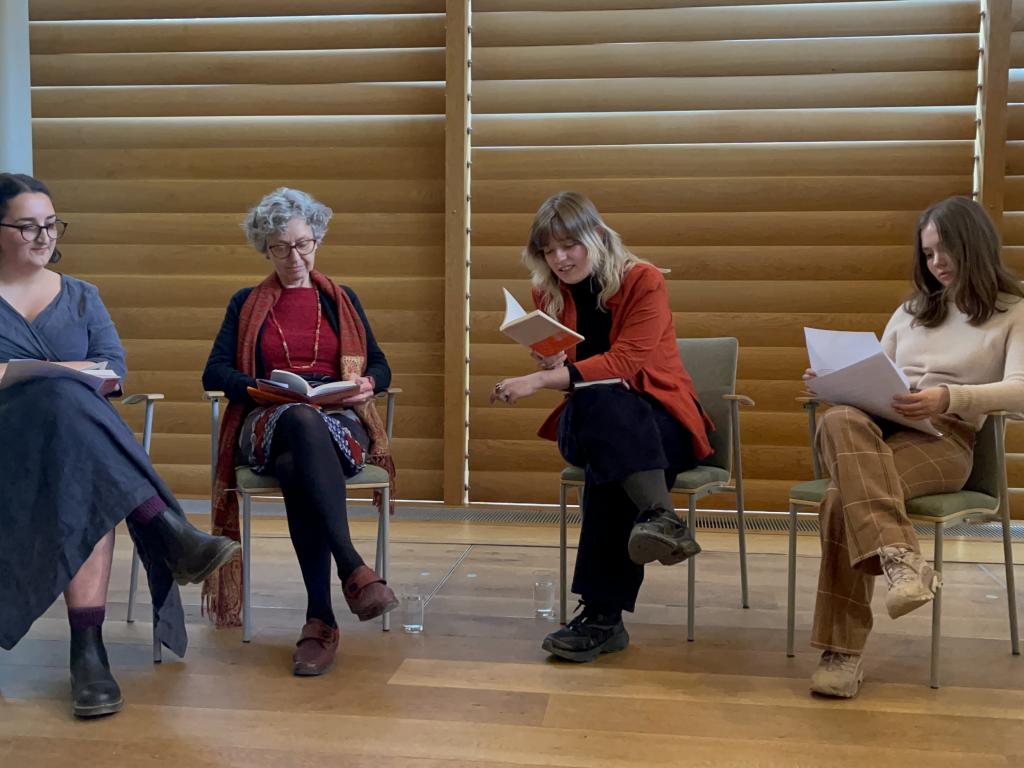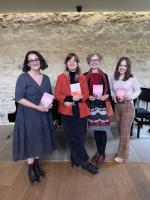
Nicol Hochholczerová’s debut novel, Tato izba sa nedá zjesť (translated as This Room Is Impossible to Eat by Julia and Peter Sherwood), shocked the Slovak literary scene with its haunting and unflinching narrative of grooming. Published in Slovak in 2021 when Hochholczerová was only twenty-two, the novel became a finalist for Slovakia’s most prestigious literary prize, the Anasoft Literary Prize, and has already appeared in translation in seven languages. On May 7th, Hochholczerová and translator Julia Sherwood were invited to discuss this remarkable debut novel and its translation into English.
The novel probes the entanglement of Tereza, a twelve-year-old girl, and Ivan, her fifty-year-old ceramics instructor. Hochcholczerová chronicles the gradual evolution of Tereza’s relationship with Ivan over the course of six years. The epistolary form of the novel affords the work an immediacy that ensnares the reader within the claustrophobic—and often revolting—dynamic between Tereza and Ivan. Hochholczerová spurns objectivity, yet the novel refuses to explicitly moralize about Ivan’s sinister grooming. However, as Hochholczerová acknowledged during our conversation, the novel’s surreal metaphors, such as fishing a hair from one’s mouth, better convey the disgust.
Hochholczerová, who received a Master’s degree in graphic design from the Academy of Art in Banská Bystrica in 2024, conceived of the book as both a physical art object and a literary text. Designed in concert with Kristína Uhráková, Tato izba sa nedá zjesť experiments with white space, typography, and other visual elements to accentuate the potency of the text. The central figures’ ages, highlighted in the upper left and right-hand corners, ominously increase as the narrative unfolds, and the font switches from serif (to represent Tereza’s diary entries) to sans serif (a third-person account of Ivan’s experience) to visualize the shift in perspective. Most significantly, the generous white space on each page both underscores the plot’s bleakness and propels the reader forward, rendering the novel a literal page-turner. As the Slovak novelist Ivana Gibová wrote in her review of Tato izba sa nedá zjesť, “this book can be devoured, but its contents will remain undigested and fermenting with us for a very, very long time. And that’s a good thing.”
The novel contributes to the robust collection of daring, experimental novels by the cohort of young Slovak women authors, such as Ivana Dobrakovová and Ivana Gibová. Born in the 1980s and 90s, this generation of authors abandoned the thematic concerns of the preceding generation–dissidence, sincerity, authenticity–and probed the psychological complexity of their unruly heroines who must navigate the tumultuous convulsions of contemporary society.

In conversation at Queen’s College, both Hochholczerová and translator Julia Sherwood were generous with their time and their answers. The novel’s unusual title, both in Slovak and in English—This Room Is Impossible to Eat—prompted thoughtful reflections from author and translator. For Hochholczerová, the question of eating is intertwined with the visceral way she sought to depict Ivan’s grooming. Rather than a didactic tone, she spoke of the efficacy of provoking a bodily reaction of disgust in her readers. For translators Julia and Peter Sherwood, the verb in the Slovak title—“zjesť”, to eat up—was difficult to translate elegantly in English, but the placeholder title they initially gave to the book had staying power, as it effectively communicated the jarring nature of the titular metaphor.
While This Room Is Impossible to Eat is focused on the disturbing dynamic between Ivan and Tereza, the narrative becomes somewhat of a Bildungsroman for Tereza, who begins writing during the course of the novel. During our conversation and after the event, Hochholczerová spoke powerfully about the importance of writing, and the various editorial processes that shape the book. She discussed her choice to incorporate Ivan’s voice in the novel, but in a more distant third person, to avoid a first-person confessional novel and instead to articulate the dark realities of grooming. Hochholczerová also spoke of seeking clear language to articulate the novel’s challenging themes, and her own editing of her writing that results in sharp and precise prose. By highlighting different elements while editing—adjectives, adverbs, and so on—a careful process of excision serves to remove any extraneous elements from the text. Instead, the images she creates are simple and indelible.
Julia and Peter Sherwood have done more to promote Slovak literature in English than anyone else: an exceedingly prolific duo, they have been translating works from Czech, Slovak, Polish, Hungarian, Russian, and German into English for almost two decades. It was enlightening to hear Julia Sherwood speak about the translation process—in particular, finding language for the charged terms of endearment that Ivan and Tereza use throughout the novel, and translating Slovak’s limited sexual vocabulary into English. She also offered fascinating insight into the collaborative nature of the translation process, including discussing alternatives with friends and family members in order to capture Tereza’s evolving voice throughout: she begins as a young girl of 12 and ends the novel as a young woman of 18.
For those interested in the finer details of literary translation, on May 8th Hochholczerová participated in a translation workshop. Attendees were invited to discuss Hochholczerová’s previously-untranslated short story, “Sladké domov”, which Julia Sherwood titled “Home sweet home” in her preliminary draft of the translation. Hochholczerová drew inspiration for this story from the dilapidated sugar factory in her hometown, Rimavská Sobota. In this surreal short story, sugar gradually subsumes a small town, and the residents, addressed in the second person, must grapple with the unforeseen consequences of this boon. A poignant parable for rampant consumerism and inflationary growth, the story warns that even the sweetest sugar can suffocate.
Across the two days that Hochholczerová spent in Oxford, audience members and workshop participants had the incredible opportunity to spend time with one of Slovakia’s most exciting new novelists, as well as the chance to learn about a literary tradition that deserves to be more widely read and translated. Many thanks to the Queen's College Translation Exchange, Oxford Comparative Criticism and Translation, Parthian Books, and all those involved in making the events possible.